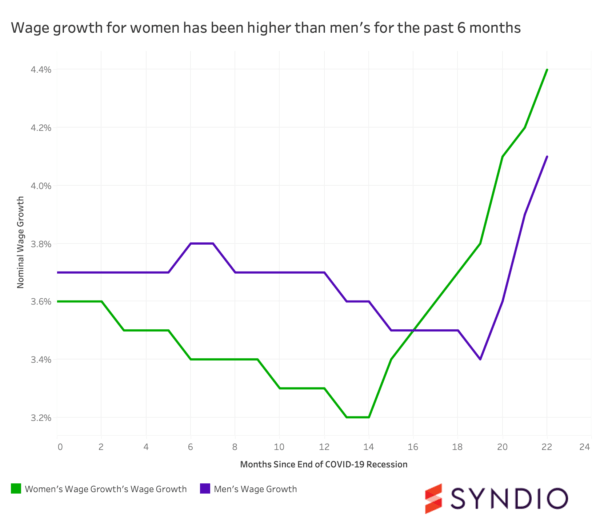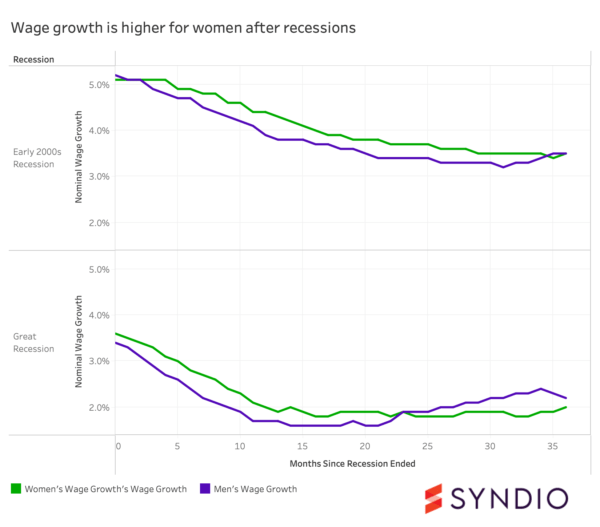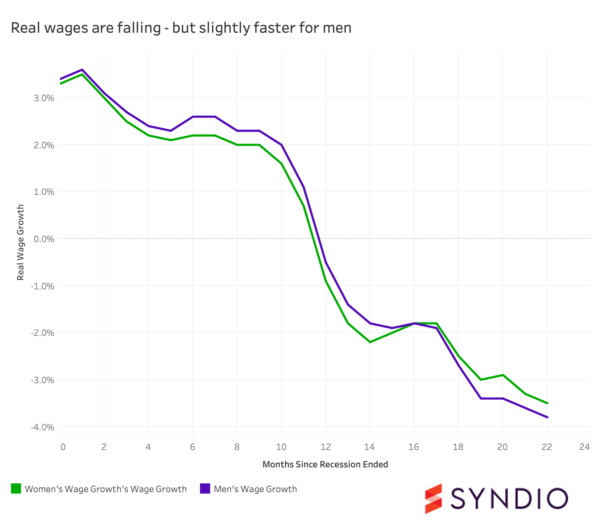Good news: wage growth has been higher for women than it has been for men for the past 6 months! Unfortunately, like some other recent good news (e.g. no gender pay gap in 22 out of 250 metro areas for young workers), you have to take this datapoint with a grain of salt for a number of reasons. Women’s current wage growth — and its implications for both employers and employees — is different than it initially appears.
1. Why higher women’s wage growth is just a silver lining
First, this good news isn’t actually that good. Women’s wage growth is currently higher than men’s because women are disproportionately represented in lower-wage service-sector jobs like personal care, food preparation, and healthcare support, which were hit particularly hard by COVID-19 shutdowns. So this “good” news is actually just a rebound from particularly bad news two years ago.
These data only account for women who stayed in or rejoined the workforce, and masks reduced labor force participation rates for women — particularly for women of color — since the pandemic began. And more obviously, this six month trend is news only because wage growth in the U.S. has been higher for men for 70% of months in the 21st century.
2. It’s not the first time – and not for great reasons
Second, women’s wage growth has outpaced men’s before, and not for reasons we want to celebrate. Other publications have pointed out that these are the biggest wage growth gains for women relative to men in the workforce since 1997. However, that’s on a monthly basis.
The current trend is a six month stretch of women’s wage growth outpacing men’s — so I explored whether we had seen a stretch this long in recent history. The answer? Yes, and not in good times — there are only two times this century where women’s wage growth has outpaced men’s for at least six months, and it was after the only other two recessions this century.
That is partly because wages are a lagging indicator — meaning they don’t go down when a recession starts. It takes some time before a recession shows itself by pushing wages down because wages are what economists call “sticky”. Economists have pointed out that wages are especially sticky if there is downward pressure — probably because wage cuts are extremely damaging to employee morale. Historically, women’s wage growth outpacing men’s has been a result of a recession, not a positive economic or societal indicator for women.
3. Wage growth is falling for everyone
Third, if this acceleration in women’s wage growth is not like the others, it’s because wage growth is worse — not better. One thing is obviously different this time. After the previous recessions, wage growth did not increase; it slowed down. It just slowed down more for men than it did for women.
However, when we look at real wages, we get a story more similar to those other recessions. Though real wage growth is rising in nominal terms, when we account for inflation (meaning the goods and services those wages can actually purchase), real wage growth is falling. In fact, this scenario is worse than the others — real wage growth fell below zero, which it did not do in the other cases.
How can companies drive progress towards closing the gender wage gap?
Employers should know that the upward pressure from employees is not going anywhere, even as they run out of room to increase wages. So how can companies continue to meet employee demands and progress towards closing their gender wage gap?
Forward-thinking companies need to recognize there are two drivers of the pay gap that are within their control: how they pay employees in similar roles (pay equity), and who they develop and select for promotions (opportunity equity). A comprehensive solution to meeting employee demands, particularly when there is so much uncertainty around wages, must include unlocking opportunities at all levels of your business. The risks of getting this wrong, especially in an extremely tight labor market, are enormous.
Achieving pay and opportunity equity is entirely within your company’s control. If you are not already proactively testing for pay differentials and establishing measurable goals for opportunity, promotion, and movement, it is time to start.





